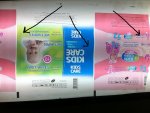You are using an out of date browser. It may not display this or other websites correctly.
You should upgrade or use an alternative browser.
You should upgrade or use an alternative browser.
Problem in flexo printing
- Thread starter abdulmuhsin
- Start date
Cornishpastythighs
Well-known member
It could be Anilox/impression bounce. is it across the web direction or with the web direction
abdulmuhsin
Member
Thank you very much
Last edited:
abdulmuhsin
Member
It could be the Anilox impression, but I don't understand the second part that you wrote.
D
Deleted member 16349
Guest
Viscosity was too high, and the lines were so many in the pictures. So I made the viscosity low, and the lines became light but still they have not gone totally.
I also cleaned the Anilox by hand, because the cleaning machine of the Anilox was damaged.
I haven't cleaned the Aniloxes in the machine for 6 months.
I have an arsoma EM 510 printing machine, and I am fresh in this field, and I printed it on polyester.
Thank you.
It seems the lines are in the machine direction but that is just a guess from the orientation of the packages/labels.
The cleaning of the anilox cylinders might be the issue. I am guessing that hand cleaning is not going to be so effective and you might not be getting some of the material out that is at the bottom of the cells. The lines do not look like the normal lines one would get if something like dirt was affecting the doctor blade but that could be also an issue.
Are you using a steel blade or a plastic blade? Enclosed blade system or open? Is the blade forward or reverse facing? Higher viscosity ink will tend to open a forward blade and that could be happening.
Maybe the pressure of the blade tip is not correct or the blade tip is too worn. It is important to get the right pressure since there will be problems with too little pressure and problem with too much pressure. It is important how the blade tip touches the anilox roller surface.
Hope the comments help.
Bill W
Well-known member
Greetings, have you tried a different print cylinder? Have you checked the TIR of the cylinder? Have you check the bearings of the plate cylinder? Are the cylinders clean and not scored or damage in any way. While a lot of "earmarking" is because of gear backlash (I am making the guess that this is not a servo press) a bad plate cylinder or it parts can also cause the problem you are dealing with.
Cornishpastythighs
Well-known member
The lines appear to go across the web direction which might indicate too much anilox pressure to plate or plate pressure to substrate (impression) This can sometimes result in a bounce at a non print area on the plate. Checking your quality targets for dot gain and solid density could help you troubleshoot pressure issues. Do the lines appear in the same place all the time or do they move?
abdulmuhsin
Member
Thank you all, thank you very much.
FlexoGrunt
Well-known member
Does this happen all the time with film or just this job?
Looking at the press two things come to mind. Not certain as there are a lot of variables that can cause this. . .
1. Could be improper impression wear (the plate isn't releasing from the analox before the idle rotation starts) if it's in very specific spots every time.
2. "Gear chatter" (what we call it). This may be the culprit as everything I've seen (my quick search of the press through the internet) regarding these presses are for labels and it looks like film you're printing here. Printing film on a label press requires changes to tooling. Gears/cyls are made to handle the thinner material and the rollers are designed differently to handle the reduction in thickness.
- Remount the same plate on the same cyl making sure the gap is in a different place. Did the lines move or not? If no then I'd start examining the plates a little more closely. If they did make sure you're set up for the material thickness you're running.
Looking at the press two things come to mind. Not certain as there are a lot of variables that can cause this. . .
1. Could be improper impression wear (the plate isn't releasing from the analox before the idle rotation starts) if it's in very specific spots every time.
2. "Gear chatter" (what we call it). This may be the culprit as everything I've seen (my quick search of the press through the internet) regarding these presses are for labels and it looks like film you're printing here. Printing film on a label press requires changes to tooling. Gears/cyls are made to handle the thinner material and the rollers are designed differently to handle the reduction in thickness.
- Remount the same plate on the same cyl making sure the gap is in a different place. Did the lines move or not? If no then I'd start examining the plates a little more closely. If they did make sure you're set up for the material thickness you're running.
Similar threads
- Replies
- 5
- Views
- 1113
PressWise
|
A 30-day Fix for Managed Chaos
As any print professional knows, printing can be managed chaos. Software that solves multiple problems and provides measurable and monetizable value has a direct impact on the bottom-line. “We reduced order entry costs by about 40%.” Significant savings in a shop that turns about 500 jobs a month. Learn how……. |












